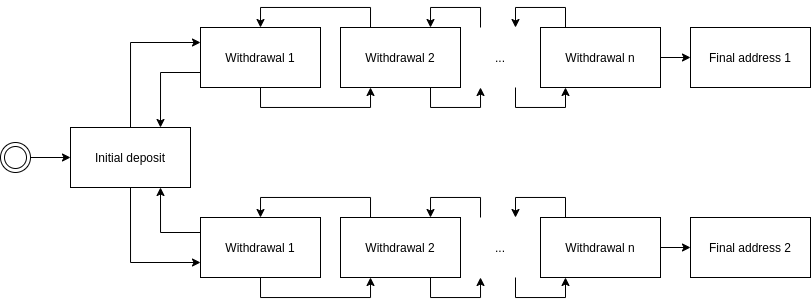
Partial Retraction – Please See Below
Drivechain’s peg-out mechanism could be implemented at the transaction level through scripts that force the funds being withdrawn from the sidechain to go through a chain of N transactions, each one of these being in a different block. More specifically, this would be implemented by creating N scripts that would contain an integer constant and would only be spendable to another copy of the same script with the constant increased or decreased by one, with the exception of the script where the constant reaches the value N, in which case the UTXO would be spendable only to a specific address provided in the beginning of the process. Furthermore, these scripts would prevent the possibility of several of them being chained in the same block through the use of OP_CSV.
Thus the protocol would look like this:
- Users that want to peg money into the drivechain would send their funds to address_X. address_X’s script would only allow the spending of coins to a
ScriptPubKeythat would follow the templateDCScript(our_address, 1), whereour_addressis a bitcoin address - Users that then want to retrieve money from the sidechain would start that process by creating a UTXO that would transfer some of the funds in address_X to an address created by computing
DCScript(our_address, 1)whereour_addressis an address that would be spendable on a payout to the group of users that created this request (enforced through OP_CTV) - Users would need to start sending transactions spending UTXOs locked in
DCScript(our_address, i)toDCScript(our_address, i+1)until reachingDCScript(our_address, N)at which point they could finally send the funds toour_address. The rationale behind drivechain also applies here, compelling miners to monitor these withdrawals and make sure that they are legal. - The funds could also be transferred from
DCScript(our_address, i)toDCScript(our_address, i-1)and fromDCScript(our_address, 1)back toadress_X, reversing the process. Users along with miners may want to do that in order to prevent an illegal withdrawal.
Pseudocode of DCScript(address_arg, i):
OP_CSV 1 //Prevent several scripts from being chained in the same block
IF i <= 0 && output.address == address_X:
SUCCEED
IF i >= N && output.address == address_arg:
SUCCEED
IF output.address == DCScript(address_arg, i+1) || output.address == DCScript(address_arg, i-1):
SUCCEED
FAIL
Note that, due to the restrictions inherent to OP_CTV, the set of possible addresses available to use as our_address must be finite and picked in the initial setup phase. Furthermore, as each possible state requires some computation, the length of the paths that a transaction can take to redemption is limited in depth and the size of any withdrawal must be within a set.
Editor’s Note: Partial Retraction
The design as suggested above doesn’t really work because the ability to recurse on the increments of the numbers doesn’t fully work.
ZmnSCPxj has pointed out how CTV, plus some other opcodes, compose to deliver Drivechain functionality, so I’ve left this page up.
Editor: Jeremy Rubin.

